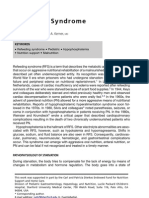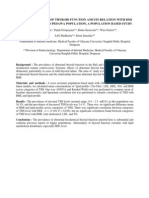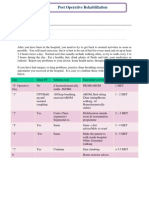Diabetic Nephropathy
Diabetic Nephropathy
Uploaded by
Made WidiastikaCopyright:
Available Formats
Diabetic Nephropathy
Diabetic Nephropathy
Uploaded by
Made WidiastikaOriginal Description:
Original Title
Copyright
Available Formats
Share this document
Did you find this document useful?
Is this content inappropriate?
Copyright:
Available Formats
Diabetic Nephropathy
Diabetic Nephropathy
Uploaded by
Made WidiastikaCopyright:
Available Formats
Diagnosis
and Treatment of
Diabetic Nephropathy
SFM Didactics
January 14, 2003
Carol Cordy, MD
1. Why should you screen for
diabetic nephropathy?
2. How should you screen for
diabetic nephropathy?
3. What should you do with
the results of your screening
tests?
Why screen? Why treat?
Prevention and treatment of
diabetic nephropathy can
reduce the incidence of end
stage renal disease and death
Diabetic Nephropathy and ESRD
Diabetic nephropathy is the leading
cause of end stage renal disease in the
United States accounting for over 40%
of dialysis patients
The 5-year mortality rate for a dialysis
patient is 93%
Dialysis for one patient costs over
$50,000 annually
Epidemiology
Type 1 Diabetic
25 - 45% will develop diabetic
nephropathy
80 - 90% with microalbuminuria will
progress to overt diabetic nephropathy
in 5 - 10 years
nearly 100% with gross proteinuria will
progress to ESRD in 7 - 10 yrs
Epidemiology
Type 2 Diabetic
50% will have microalbuminuria at the
time of presentation probably secondary
to HTN
10-20% with microalbuminuria will
progress to overt nephropathy
minority populations have a 2 to 20-fold
higher incidence of diabetic nephropathy
Risk Factors for Diabetic
Nephropathy
Age, Race, Ethnicity
History of microalbuminuria
Hypertension
Poor glycemic control
Smoking
Family history of nephropathy
genetic abnormalities of ACE gene
Stage I Hyperfiltration - increased blood
flow through the kidney, early renal
hypertrophy
Stage II - Glomerular lesions without
clinically evident disease
Stage III - Incipient nephropathy with
microalbuminuria - alb/cr ratio .03 - .3 or
albumin 20-200 mcg/min on timed specimen
Stages of
Diabetic Nephropathy
Stages of
Diabetic Nephropathy
0
20
40
60
80
100
120
140
160
180
0 5 10 15 20 25 30
Duration of Diabetes
G
F
R
I
II
III
IV
V
Stages of
Diabetic Nephropathy
Stage IV - Overt diabetic nephropathy
with proteinuria >500 mg/24 hr
- creatinine clearance <70 ml/min
Stage V End stage renal disease
(ESRD)
- creatinine clearance <15 ml/min
- creatinine = 6mg/dl
Stages of
Diabetic Nephropathy
0
20
40
60
80
100
120
140
160
180
0 5 10 15 20 25 30
Duration of Diabetes
G
F
R
I
II
III
IV
V
Primary care physicians have the
most frequent contact with
diabetic patients and therefore
have the greatest potential to
favorably affect their health
How are we doing?
Studies show that primary
care physicians screen only
20% of their diabetic
patients for diabetic
nephropathy
How are we doing?
Once screened many
physicians are not sure
what to do with the results
Diabetic Nephropathy
Algorithm
Evidence-based approach
Goal
The use of the algorithm will improve
renal function screening in the diabetic
population and encourage the initiation
of appropriate therapy in patients with
all stages of renal disease
Using the Algorithm
Urinalysis f or prote in
UA ma y be f alsel y po si ti ve o r el evated i n the
setti ng of poor glu cose contr ol,
UTI, heavy exe rcise, fever or sepsis- -tre at as
appr opri ate be fore r e-testi ng.
Positi ve for p rotei n
1+ o r gr eater
Ref er to Nephrology
for di agnosis, treatment
opti ons & pati ent
preparation & educati on
Consider Consult
with Nephrology
for di agnosis and
treatment options
Ini tia l or annual
Test for Al bumi nuri a
Is K+>5.5
or
Cr >2.0?
Macroa lbuminur ia ?
1+ o r gr eater
Begin Tre atment :
1. ACE Inhibitor or al ternative therapy
2. Annual creati ni ne, potassi um and UA
3. Conti nue Protecti ve Recommendati ons as
li sted below.
Rep eat mi cr oal bumin uri a
test
2 of 3 Tests
posi tive?
Annual test for
mi cr oal bumi nuri a
B
Yes Yes
No No
Yes
No
Yes
No
B Annually
A
A
On ACE-I nhibi tor ?
No
Yes
C
Is microalbuminuria pre sent ?
mi cr oal bumi nuri a:
0.03- 0.30 mg a lbumin/mg cr eati nine ;
30- 300 gm albumin/mg cr eati nin e (spot coll ecti on);
20- 200 gm albumin/min ( timed co ll ection ); or
30- 300 mg al bumi n/24hr (24 hr col lecti on)
Yes
Quanti tate total pr otein wi th a 24- hour
ur ine speci men or a sp ot AM prote in/
creati ni ne ra tio ( mg pr otei n/mg
creati ni ne)
Is uri ne pr otei n>1g/day or 1000mg/g
creati ni ne or rati o>1.0?
Yes
No
C
Type 1 and Type 2; age 12 years and ol der with no over t renal di sease
Renal Prot ecti ve Recommendat ions for persons wit h diabet es:
1. St ri ct glucose cont rol measured by glycat ed hemoglobin<7.0
2. Blood pressure cont rol<130/85
3. Lipid evaluation and treatment per estalis hed guidelines
UA (Urine Dipstick)
Use as an initial screen for all patients
Negative to trace proteinuria requires
further testing for microalbuminuria
1+ or greater proteinuria requires
further testing to quantitate proteinuria
Once a patient has microalbuminuria,
UA (urine dipstick) testing for gross
proteinuria may be adequate although
yearly testing for albuminuria may
have become standard of care
Microalbuminuria
Spot AM urine: Alb/Cr ratio .03-.3*
Timed urine collection: 20-200g
albumin/min
24 hour urine collection: 30-300 mg
albumin in 24 hours
*This is the most practical test
Microalbumin Testing
Factors that Cause False Positive Test
poorly controlled diabetes
morbid obesity
acute illness, fever, UTI
pregnancy, menstruation
high protein diet
CHF
hematuria, major stress: surgery or
anesthesia
Incipient Nephropathy
Type 1 Diabetes
2 out of 3 urine tests + for
microalbuminuria (start screening 5 years
after the initial diagnosis)
presence of proliferative diabetic
retinopathy
80-90% of type 1 patients with
microalbuminuria will progress to DN
Incipient Nephropathy
Type 2 Diabetes
2 out of 3 urine tests + for
microalbuminuria (start screening at the
time of diagnosis of diabetes)
presence of diabetic retinopathy
20-30% may have diabetic nephropathy
but not diabetic retinopathy
25% may have a diagnosis of nephropathy
other than diabetic nephropathy
Macroalbuminuria
Spot AM urine: Alb/Cr ratio greater
than .3
Timed urine collection: greater than
200g albumin/min
24 hour urine collection: greater
than 300 mg albumin in 24 hours
If macroalbuminuria is present then test
for gross proteinuria
Gross Proteinuria
Defined as urine protein >500mg/24 hr.
Gold standard test is
24 hour urine collection for total protein
and creatinine clearance
Can also test protein/creatinine ratio
measures total mg protein/mg creatinine
correlates 1:1 with a 24 hr urine in
grams/24 hr
less accurate in ARF, intersitial nephritis,
high degrees of proteinuria
Overt Diabetic Nephropathy
Gold Standard is biopsy
Diagnosis can be made by clinical history and
exclusion of other renal disease
Workup includes
Renal ultrasound for size, shape,
abnormalities
24 hour urine for total protein and
creatinine clearance
Treatment
Lifestyle changes
Lose weight
Stop smoking
Low salt diet for BP control
Low protein diet?
Glycemic Control
Benefit in both Type 1 and Type 2 patients
Recommended: HbA1C <7.0%
(some say <6.5%)
Blood Pressure Control
Current ADA recommendations are for
blood pressure <130/80-85 (if
nephropathy <125/75)
Several randomized controlled trials
indicate that improved blood pressure
control decreases the rate of
progression of renal disease in both
type 1 and type 2 patients
ACEs and ARBs
Angiotensin converting enzyme inhibitors
and angiotensin receptor blocking agents
have been shown in animal models and in
randomized controlled trials to improve
diabetic nephropathy
Mechanism of action - ACE-inhibitors limit
angiotensin II production by blocking
angiotensin converting enzyme, ARB-agents
block angiotensin II receptors
Questions for future studies
Will higher doses of ACEs and ARBs improve
outcome and decrease microalbuminuria?
Will patients without microalbuminuria benefit
from the use of ACEs and ARBs?
What about other BP medications for patients
who cannot tolerate ACEs and ARBs?
Which of the newer oral agents for glucose
control are also renal protective?
Is there a place for low protein diets for
diabetics before renal disease develops?
Case #1
Your first patient is a 25 year old
young man with a 5 year history of
type 1 diabetes. His urine dipstick
is negative for protein. You check a
spot AM urine alb/cr ratio which is
.019. His blood pressure is 112/66.
His HbA1C is 6.9.
Which is (are) true?
1. The patient has early or incipient diabetic
nephropathy.
2. The patient should maintain a HbA1C of
less than 7 to help protect his kidneys.
3. You should start the patient on an ACE
inhibitor to protect his kidneys.
4. All of the above are true.
Patient #2
Your next patient is a 43 year old
woman with a six year history of
type 2 diabetes. A urine dip shows
trace protein and a spot AM urine
alb/cr ratio is .039. Her blood
pressure is 135/80 and her HbA1C
is 6.7.
Which is (are) not true?
1. You should check the patients serum
creatinine and potassium.
2. You should start the patient on an ACE
inhibitor if her K+ and Cr are okay.
3. You should check a 24 hour urine for
total protein and creatinine clearance.
4. The patient has overt diabetic
nephropathy and should be referred to a
nephrologist.
Case #3
Your last patient is a 60 year old
with HTN, dyslipidemia and newly
diagnosed type 2 diabetes. A urine
dip shows 2+ protein. He has a
fever and his HbA1C is 10.3. His
blood pressure is 140/88. He is
taking HCTZ and glipizide.
Which is (are) true?
1. You should get the patients diabetes
under better control before rechecking
his urine.
2. A fever will not cause proteinuria.
3. The patients blood pressure is under
good control.
4. You should check the patients
potassium and creatinine.
Case #3
Three months later with exercise,
metformin and enalapril your
patients HbA1C is now 7.5 and his
blood pressure is 135/85. A urine
dip now shows 1+ protein.
Which is (are) true?
1. You should check a 24 hour urine for
total protein and cr. cl.
2. A spot AM urine albumin/creatinine
ratio correlates well with a 24 hour
urine for total protein
3. The patient likely already has diabetic
nephropathy and should be referred to
a nephrologist.
Use the Algorithm!
Check all your diabetic patients
annually for renal disease .
Help your diabetic patients protect
their kidneys by helping them keep
their diabetes under control.
Help your diabetic patients protect
their kidneys by helping them keep
their blood pressure under control.
You might also like
- Sibo QuestionnaireDocument2 pagesSibo QuestionnaireNoorAk0% (1)
- DFPP PresentationDocument34 pagesDFPP PresentationMihai SavaNo ratings yet
- 2013-Power Output and Electromyography Activity of The Back Squat Exercise With Cluster SetsDocument9 pages2013-Power Output and Electromyography Activity of The Back Squat Exercise With Cluster SetsA man about townNo ratings yet
- The Wild Diet by Abel JamesDocument124 pagesThe Wild Diet by Abel JamesReneNo ratings yet
- Nephrology - Proteinuria - SOAP Note - Manish Suneja PDFDocument4 pagesNephrology - Proteinuria - SOAP Note - Manish Suneja PDFΝίκος ΣυρίγοςNo ratings yet
- AKI Vs CKD Lecture Latest 3rd Dec 2018Document51 pagesAKI Vs CKD Lecture Latest 3rd Dec 2018mugilessNo ratings yet
- Heme Quiz 1-3Document14 pagesHeme Quiz 1-3Søren KierkegaardNo ratings yet
- Uptodate Subscription DetailsDocument2 pagesUptodate Subscription DetailssoftintNo ratings yet
- Readiness Assurance Test - ANEMIADocument3 pagesReadiness Assurance Test - ANEMIADan Ali0% (1)
- Therapy RCT Critical Appraisal Worksheet With ExplanationDocument2 pagesTherapy RCT Critical Appraisal Worksheet With ExplanationAdwin AlamsyaputraNo ratings yet
- Part 2 Exam Sample Q 2015Document194 pagesPart 2 Exam Sample Q 2015Abdul QuyyumNo ratings yet
- Acquired Hemolytic Anemia Presentation For BPharmDocument24 pagesAcquired Hemolytic Anemia Presentation For BPharmHiren Pathak100% (2)
- Lean System Success Plan DownloadDocument119 pagesLean System Success Plan DownloadTash Gee-Gooch100% (1)
- ACR Albumin Creatinine Ratio To Be PRESENTED BY HMN TO THE NEW MED TECH TRAINEES IN JAHRA HEALTH CENTER Apr 23 2014Document22 pagesACR Albumin Creatinine Ratio To Be PRESENTED BY HMN TO THE NEW MED TECH TRAINEES IN JAHRA HEALTH CENTER Apr 23 2014honorinanuguidNo ratings yet
- Diabetes and NephrologyDocument36 pagesDiabetes and NephrologydrpbendreNo ratings yet
- Hemodiafiltration Kuhlmann PDFDocument31 pagesHemodiafiltration Kuhlmann PDFDavid SantosoNo ratings yet
- Heme Degradation & HyperbilirubinemiasDocument30 pagesHeme Degradation & HyperbilirubinemiasSubhi MishraNo ratings yet
- Hiv-Associated Nephropathy (Hivan) : DR KibaruDocument27 pagesHiv-Associated Nephropathy (Hivan) : DR KibaruMalueth AnguiNo ratings yet
- Cardiorenal SyndromeDocument89 pagesCardiorenal SyndromeGabriyah HamzahNo ratings yet
- Renal PharmacologyDocument52 pagesRenal Pharmacologyashraf0% (1)
- Intradialytic Parenteral Nutrition PDFDocument5 pagesIntradialytic Parenteral Nutrition PDFRaymond IbrahimNo ratings yet
- Peritoneal Dialysis AdequacyDocument33 pagesPeritoneal Dialysis AdequacyKong Kong KongNo ratings yet
- Urine AnalysisDocument53 pagesUrine AnalysisMaath KhalidNo ratings yet
- CPG Management of Dengue Infection in Adults (Revised 2nd Edition)Document68 pagesCPG Management of Dengue Infection in Adults (Revised 2nd Edition)umiraihana1No ratings yet
- Practice TESTS NephrologyDocument56 pagesPractice TESTS NephrologyFabiola AlonsoNo ratings yet
- Diabetic Nephropathy: Assisstant Professor Dr. Mihaela-Dora DonciuDocument65 pagesDiabetic Nephropathy: Assisstant Professor Dr. Mihaela-Dora DonciuFloreaAndreiNo ratings yet
- Acute Hemodialysis PrescriptionDocument18 pagesAcute Hemodialysis PrescriptionOlga Babii100% (1)
- Alport Syndrome Genetic ResearchDocument4 pagesAlport Syndrome Genetic ResearchVenson CeaNo ratings yet
- Nephrology Certification Examination Blueprint - American Board of Internal MedicineDocument4 pagesNephrology Certification Examination Blueprint - American Board of Internal MedicineabimorgNo ratings yet
- Diabetic NephropathyDocument176 pagesDiabetic NephropathyJosé RamírezNo ratings yet
- Tubulopathies. Interstitial NephritisDocument34 pagesTubulopathies. Interstitial NephritisIaros OlgaNo ratings yet
- Diabetic NephropathyDocument6 pagesDiabetic NephropathyZulfadliZulfadliNo ratings yet
- Renal ClearanceDocument22 pagesRenal ClearanceMohammed ArarNo ratings yet
- Renal Replacement TherapyDocument19 pagesRenal Replacement Therapyayuwulandari100% (1)
- Clinical Approach To RPRF PDFDocument6 pagesClinical Approach To RPRF PDFshankarNo ratings yet
- Surviving Sepsis Campaign 2021Document37 pagesSurviving Sepsis Campaign 2021Alvast VastraNo ratings yet
- Acute Hemodialysis PrescriptionDocument13 pagesAcute Hemodialysis PrescriptionR DNo ratings yet
- Guidelines For Platelet Transfusions in Dengue FeverDocument4 pagesGuidelines For Platelet Transfusions in Dengue FeverGuru Prasad100% (1)
- Dialysisprescription2 161102121138Document61 pagesDialysisprescription2 161102121138ZH. omg sar100% (1)
- SCE Nephrology Book 20106Document210 pagesSCE Nephrology Book 20106Sagvan Hajani100% (1)
- Refeeding SyndromeDocument10 pagesRefeeding SyndromeEstefany GonzalezNo ratings yet
- Interventional NephrologyDocument5 pagesInterventional Nephrologyfouad tabet100% (1)
- Diabetic Kidney Disease: From Physiology To TherapeuticsDocument16 pagesDiabetic Kidney Disease: From Physiology To TherapeuticsdevyNo ratings yet
- Telemedicine and Remote Monitoring in Cirrhosis Care: Revolutionizing Patient ManagementDocument7 pagesTelemedicine and Remote Monitoring in Cirrhosis Care: Revolutionizing Patient ManagementInternational Journal of Innovative Science and Research TechnologyNo ratings yet
- Prof. Syakib Acute Kidney Injury - Internal Medicine Emergency Course - Agustus 2019-DikonversiDocument35 pagesProf. Syakib Acute Kidney Injury - Internal Medicine Emergency Course - Agustus 2019-DikonversidrroytambunanNo ratings yet
- Kidney Diseases Associated With Human Immunodeficiency Virus InfectionDocument24 pagesKidney Diseases Associated With Human Immunodeficiency Virus InfectionNadya Meilinar SamsonNo ratings yet
- Liver Cirrhosis (VD)Document56 pagesLiver Cirrhosis (VD)HannaTashiaClaudiaNo ratings yet
- Tatalaksana Lupus Nefritis, Dr. Edi HidayatDocument34 pagesTatalaksana Lupus Nefritis, Dr. Edi HidayatDr Edi Hidayat100% (1)
- Aki 2018Document45 pagesAki 2018NURUL ROMADHONNo ratings yet
- Overview of Heavy Proteinuria and The Nephrotic Syndrome - UpToDateDocument34 pagesOverview of Heavy Proteinuria and The Nephrotic Syndrome - UpToDatechristian47No ratings yet
- Hemodialysis Adequacy: SMF Ginjal Hipertensi Dept. Penyakit Dalam RSPAD Gatot Subroto JakartaDocument81 pagesHemodialysis Adequacy: SMF Ginjal Hipertensi Dept. Penyakit Dalam RSPAD Gatot Subroto JakartaEvi PutriNo ratings yet
- CKD MBD GuidelineDocument65 pagesCKD MBD GuidelinehoracioNo ratings yet
- Empa-Kidney 1Document5 pagesEmpa-Kidney 1api-660408385No ratings yet
- P-LCR Parameter - Platelet Large Cell Ratio - Medical LaboratoriesDocument3 pagesP-LCR Parameter - Platelet Large Cell Ratio - Medical LaboratorieshardianNo ratings yet
- Acute Kidney InjuryDocument15 pagesAcute Kidney InjuryManish VijayNo ratings yet
- CytoSorb Booklet EN 1.0 PDFDocument58 pagesCytoSorb Booklet EN 1.0 PDFlemnariuNo ratings yet
- Kidney Biopsy Finding of The Glomeruli - SUN 2019Document78 pagesKidney Biopsy Finding of The Glomeruli - SUN 2019Galih AryyagunawanNo ratings yet
- Nephrology Review NotesDocument6 pagesNephrology Review NotesEdilberto HernandezNo ratings yet
- Nephrology Clearance: Dr. JC E. Loren Dept. of Internal Medicine Southern Philippines Medical Center February 14, 2011Document25 pagesNephrology Clearance: Dr. JC E. Loren Dept. of Internal Medicine Southern Philippines Medical Center February 14, 2011Jay-iSinganonNo ratings yet
- National ART Clinical Guideline 2023 - 04 - 28 SignedDocument44 pagesNational ART Clinical Guideline 2023 - 04 - 28 SignedZimkita Zintle MakeleniNo ratings yet
- Patient Information Handout: Am Fam PhysicianDocument5 pagesPatient Information Handout: Am Fam PhysicianJacky Lou Tabamo LumacadNo ratings yet
- Acute and Chronic CholecystitisDocument18 pagesAcute and Chronic CholecystitisMade WidiastikaNo ratings yet
- Haart: Who Guideline 2010 RevisedDocument9 pagesHaart: Who Guideline 2010 RevisedMade WidiastikaNo ratings yet
- Abstract-Thyroid SUDEMA EditDocument1 pageAbstract-Thyroid SUDEMA EditMade WidiastikaNo ratings yet
- Abstrack Toxo 1Document1 pageAbstrack Toxo 1Made WidiastikaNo ratings yet
- CHM160L Experiment 5 PDFDocument8 pagesCHM160L Experiment 5 PDFCNo ratings yet
- Drug StudyDocument14 pagesDrug StudyJenniferValmocenaNo ratings yet
- NFSC 431 Understanding Food Addiction PowerpointDocument21 pagesNFSC 431 Understanding Food Addiction Powerpointapi-254931633No ratings yet
- Online Health CalculatorsDocument3 pagesOnline Health CalculatorsjohntandraNo ratings yet
- Research Based Argument 1Document8 pagesResearch Based Argument 1api-458357311No ratings yet
- Polycystic Ovary SyndromeDocument13 pagesPolycystic Ovary SyndromeLIZARDO CRUZADO DIAZNo ratings yet
- Episode 1 Emily in ParisDocument18 pagesEpisode 1 Emily in Paris6yzzgdcyzyNo ratings yet
- Diet Plan PDFDocument9 pagesDiet Plan PDFComet ShopNo ratings yet
- Gssa Coaching Manual - Part 3Document24 pagesGssa Coaching Manual - Part 3Dragan Miskovic100% (1)
- Surefire English BusinessDocument47 pagesSurefire English BusinessLuis Silveiro100% (4)
- CATS & DOGS Nutrition PDFDocument71 pagesCATS & DOGS Nutrition PDFErald Renz LaurenteNo ratings yet
- Fakultas Keperawatan Universitas RiauDocument11 pagesFakultas Keperawatan Universitas RiauwantiNo ratings yet
- Christina Brown - Whole Foods Cover LetterDocument2 pagesChristina Brown - Whole Foods Cover LetterChristinaBolichBrownNo ratings yet
- Diabetes Comprehensive T2DM Management: Hemi SinoritaDocument55 pagesDiabetes Comprehensive T2DM Management: Hemi SinoritaJipeeZedNo ratings yet
- Scientific Research Journal of India ScReJI Volume 7 Issue 2 Year 2023Document53 pagesScientific Research Journal of India ScReJI Volume 7 Issue 2 Year 2023Dr. Krishna N. SharmaNo ratings yet
- Andrey Caro 10-5-17 Sheet1Document4 pagesAndrey Caro 10-5-17 Sheet1Andrey CaroNo ratings yet
- Landry 2023 Oi 231297 1700251908.10956Document13 pagesLandry 2023 Oi 231297 1700251908.10956Daniel BeckerNo ratings yet
- Triptico LeslyDocument2 pagesTriptico LeslySelomit Keila Fernandez LlerenaNo ratings yet
- Hypertension and ExerciseDocument8 pagesHypertension and ExercisemeyqiNo ratings yet
- An Ayurvedic Approach To ObesityDocument11 pagesAn Ayurvedic Approach To ObesitySanjay SoniNo ratings yet
- The Cholestrol LieDocument4 pagesThe Cholestrol LieVijay Khanna100% (1)
- Nutrition Facts Nutrition Facts Nutrition Facts Nutrition FactsDocument8 pagesNutrition Facts Nutrition Facts Nutrition Facts Nutrition FactsroshanjoseNo ratings yet
- Abstrak Jamhesic Dr. Huntari Harahap BaruDocument2 pagesAbstrak Jamhesic Dr. Huntari Harahap BaruAndika SulistiawanNo ratings yet
- Home Exercise ProgramDocument6 pagesHome Exercise ProgramRavin NarwalNo ratings yet
- German Volume TrainingDocument10 pagesGerman Volume TrainingErick MoraNo ratings yet
- Gestational Diabetes IrDocument10 pagesGestational Diabetes IrChikezie OnwukweNo ratings yet





























































































